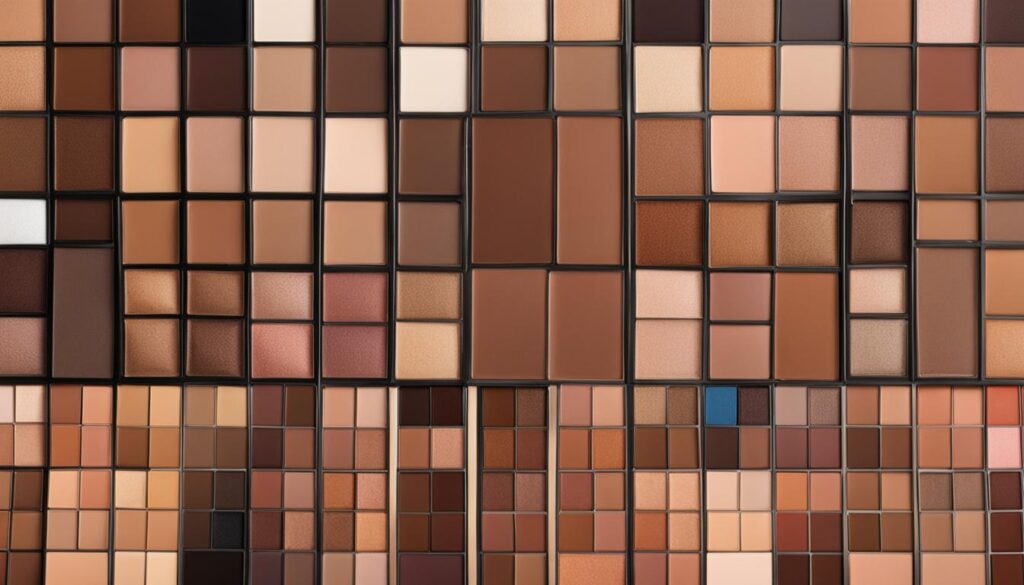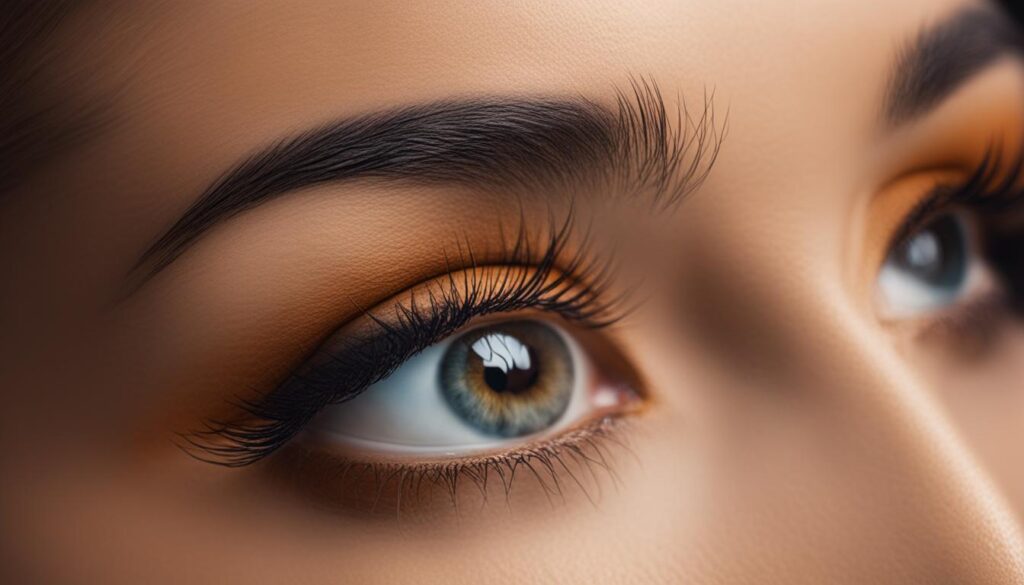We may earn money or products from the companies mentioned in this post.
When it comes to achieving a flawless complexion, selecting the right foundation is key. However, with so many options available, finding the perfect match can feel overwhelming. That’s why we’ve created this comprehensive guide to help you navigate through the world of foundation selection.
We’ll start by exploring the importance of understanding your skin type and tone, and how it can impact the foundation you choose. From there, we’ll dive into the various foundation types available in the market and provide expert tips to help you make an informed decision. By the end of this guide, you’ll be equipped with all the information you need to find the perfect foundation that suits your skin.
Key Takeaways
- Choosing the right foundation can enhance your natural beauty and create a flawless complexion.
- Understanding your skin type and tone is crucial in determining the right foundation for you.
- There are various foundation types available in the market, each with their own benefits and drawbacks.
- Expert tips can help you navigate through the sea of foundation options and make an informed decision.
- Experimenting with different foundations can help you find the perfect match for your skin.
Understanding Your Skin Type and Tone
Choosing the right foundation starts with understanding your skin type and tone. While foundation is meant to enhance your skin’s natural beauty, it can only do so if it’s chosen wisely.
Skin Type
The first step in understanding your skin is to determine your skin type. There are typically five different skin types: oily, dry, combination, sensitive, and normal.
- Oily skin: the face appears shiny due to excess sebum production.
- Dry skin: the face appears tight and flaky due to lack of moisture.
- Combination skin: the face has a mix of oily and dry areas.
- Sensitive skin: the face is easily irritated by products and environmental factors.
- Normal skin: the face has balanced oil production and a generally even skin tone.
Different skin types may require different formulations and finishes of foundation. For example, those with oily skin may want to look for a matte or oil-free foundation, while those with dry skin may need a more hydrating formula.
Skin Tone
Once you’ve determined your skin type, it’s important to understand your skin tone. Skin tone refers to the natural color of your skin.
| Fair/Light | Medium | Tan | Deep |
|---|---|---|---|
| Pale ivory or beige, burns easily | Warm beige or olive, tans easily | Golden or caramel, rarely burns | Deep brown or ebony, never burns |
Once you’ve determined your skin tone, it’s important to select a foundation shade that complements it.
Foundation Types
Now that you understand your skin type and tone, it’s time to explore different foundation types.
- Liquid foundation: a classic foundation that comes in various finishes. Usually provides medium to full coverage.
- Cream foundation: a thicker consistency, often providing full coverage.
- Powder foundation: a lightweight formula, often providing light to medium coverage.
- Stick foundation: a cream-to-powder formula, often providing medium to full coverage.
- Cushion foundation: a liquid formula in a compact, often providing light to medium coverage.
Each foundation type has its own advantages and disadvantages, and the right one for you depends on your skin type and personal preferences.
Exploring Different Foundation Types
Choosing the right foundation can be a daunting task, especially with so many different foundation types available. From sheer to full coverage, each foundation type has its unique benefits and drawbacks. To help you make an informed decision, we’ve put together a comprehensive guide to different foundation types.
Liquid Foundation
Liquid foundations are the most common type of foundation available in the market. They are versatile and provide buildable coverage, making them suitable for most skin types and occasions. Liquid foundations are available in a wide range of finishes, from matte to dewy, and formulas, such as oil-free and hydrating.
Cream Foundation
Cream foundations are a thicker consistency than liquid foundations, providing full coverage to even out skin tone and conceal imperfections. They are suitable for dry skin types as they have a creamy texture that can provide moisture to the skin. Cream foundations are also longer-lasting than liquid foundations.
Powder Foundation
Powder foundations are ideal for those with oily skin types as they can absorb excess oil and provide a matte finish. They are available in both loose and pressed formulas and are easy to apply with a brush or sponge. Powder foundations are lightweight and have a natural finish, making them great for everyday wear.
Mousse Foundation
Mousse foundations have a light, fluffy texture that blends effortlessly into the skin, providing a smooth and blemish-free finish. They are suitable for those with normal to oily skin types and offer medium to full coverage. Mousse foundations are easy to apply and are long-lasting.
Cushion Foundation
Cushion foundations are a Korean beauty trend that has gained popularity in recent years. They come in a compact with a sponge applicator that dispenses the foundation. Cushion foundations provide a natural, dewy finish and are ideal for those with dry to normal skin types. They offer sheer to medium coverage and can be reapplied throughout the day for touch-ups.
Stick Foundation
Stick foundations are convenient and easy to use. They come in a twist-up tube and can be applied directly to the skin. Stick foundations provide medium to full coverage and are available in a variety of finishes, including matte and dewy. They are ideal for those with normal to dry skin types.
Tinted Moisturizer
Tinted moisturizers are a lightweight alternative to foundation, providing minimal coverage with added hydration. They are suitable for all skin types, particularly those with dry or sensitive skin. Tinted moisturizers are ideal for achieving a natural, no-makeup look.
Now that you are familiar with the different types of foundation available, you can make an informed decision about the best foundation for your skin type and desired coverage. Keep in mind that foundation selection is a personal preference and experimentation is key to finding your perfect match.
Tips for Choosing the Perfect Foundation
Choosing the right foundation can be a daunting task, but these expert tips will make the process a breeze.
Determine Your Skin Type and Undertone
Before picking up any foundation, it’s important to understand your skin type and undertone. If you have oily skin, consider a matte or oil-free formula that won’t clog your pores. Dry skin types should opt for a hydrating or dewy finish to boost moisture levels. If you’re unsure about your undertone, look at the veins on your wrist. If they appear blue or purple, you have cool undertones, while green veins indicate warm undertones. If you can’t tell, you may have neutral undertones.
Match Your Shade
Finding the right shade for your skin is crucial for a flawless finish. To ensure an accurate match, test the foundation on your jawline, as it should blend seamlessly with your neck and chest. Natural light is the best way to see how the foundation looks on your skin. If you’re still unsure about the shade, consider testing a few different ones to see how they wear throughout the day.
Consider Your Coverage Preferences
The coverage level of your foundation can make all the difference in the final look. Sheer formulas provide a natural, dewy finish and allow your skin to shine through, while full coverage formulas provide maximum coverage for blemishes and discoloration. If you prefer something in-between, a medium coverage foundation may be just what you’re looking for.
Don’t Forget About Application
The way you apply your foundation can also impact the final result. A beauty sponge can provide a seamless finish, while a brush can provide a more airbrushed look. If you’re using your fingers, make sure to blend the foundation evenly to avoid any streaks or patches.
By following these tips, you’ll be well on your way to finding the perfect foundation that enhances your natural beauty.
Conclusion
In conclusion, selecting the perfect foundation can be a daunting task, but it doesn’t have to be. By understanding your skin type and undertone, exploring different foundation types, and following expert tips, you can find the right foundation that enhances your natural beauty and achieves a flawless complexion.
Experimentation is Key
Remember, foundation selection is a personal journey, and what works for someone else may not work for you. Don’t be afraid to experiment with different foundation formulas and shades until you find your perfect match. With this guide, you now have the knowledge and tools to make an informed decision when selecting your foundation.
Love Your Skin
Finally, it’s essential to remember that foundation is just one of the many tools you can use to enhance your natural beauty. Taking care of your skin through a consistent skincare routine and a healthy lifestyle is equally important in achieving flawless-looking skin. Embrace your unique beauty and have fun experimenting with different makeup looks!
FAQ
How do I determine my skin type?
To determine your skin type, observe how your skin feels and looks throughout the day. Oily skin tends to appear shiny and may have visible pores. Dry skin often feels tight and may have flaky patches. Combination skin has areas of both oiliness and dryness. Normal skin is balanced and does not experience excessive oiliness or dryness.
How do I determine my skin tone?
To determine your skin tone, look at the veins on your wrist. If they appear bluish, you likely have cool undertones. If they appear greenish, you likely have warm undertones. If you can’t clearly determine the color, you may have neutral undertones. You can also consider how your skin reacts to different colors. Cool-toned skin often looks better in silver jewelry, while warm-toned skin tends to complement gold jewelry.
What is the best foundation type for oily skin?
For oily skin, a matte or oil-free foundation is recommended to control shine and minimize the appearance of pores. Powder foundations or oil-free liquid foundations with a matte finish work well for oily skin types.
What is the best foundation type for dry skin?
Dry skin benefits from hydrating foundations that provide moisture and create a dewy finish. Look for liquid or cream foundations with hydrating ingredients such as hyaluronic acid or glycerin.
How do I find the right foundation shade?
When selecting a foundation shade, it’s best to test it on your jawline or neck to ensure a seamless blend with your natural skin tone. Consider natural lighting when assessing the shade. It’s also helpful to seek guidance from a makeup professional or try sample sizes before committing to a full-size product.
How should I apply foundation?
There are various methods to apply foundation, including using brushes, sponges, or your fingers. Choose a technique that works best for you. Start by applying small amounts and building the coverage gradually. Blend the foundation evenly, ensuring no harsh lines or streaks.
How often should I replace my foundation?
It is generally recommended to replace liquid or cream foundations every 6-12 months and powder foundations every 12-18 months. However, always check the expiration date and pay attention to any changes in the product’s consistency or smell, as these signs may indicate the need for immediate replacement.
Affiliate Disclosure: This post may contain affiliate links. If you purchase through our link, we may receive a small commission, but at no additional cost to you. For more information, please see our Disclosure statement.



